Przerowa is a Polish coat of arms. It was used by several szlachta families in the times of the Polish–Lithuanian Commonwealth.
Przerowa is a Polish coat of arms. It was used by several szlachta families in the times of the Polish–Lithuanian Commonwealth.

| | This section is empty. You can help by adding to it. (July 2010) |
Notable bearers of this coat of arms include:

Ossorya is a Polish coat of arms. It was used by several szlachta families in the times of the Polish–Lithuanian Commonwealth.

Oksza - is a Polish coat of arms. It was used by several szlachta families in the times of the Polish–Lithuanian Commonwealth.
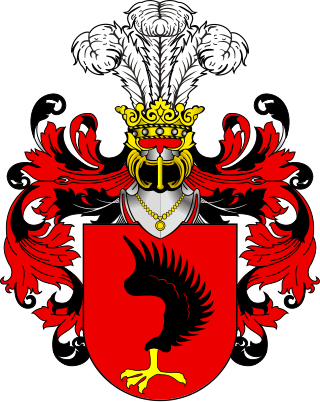
Kopacz is a Polish coat of arms. It was used by several szlachta families in the times of the Kingdom of Poland and Polish–Lithuanian Commonwealth.

Grzymała is a Polish coat of arms. It was used by several szlachta families in the times of the Polish–Lithuanian Commonwealth.

Geysztor or Gieysztor is a Polish coat of arms. It was used by several Szlachta families in the times of the Polish–Lithuanian Commonwealth.

Mogiła is a Polish coat of arms. It was used by a number of szlachta (noble) families under the Polish–Lithuanian Commonwealth.

Odyniec is a Polish coat of arms. It was used by several szlachta (noble) families under the Polish–Lithuanian Commonwealth.

Prus I is a Polish coat of arms. It was used by a number of szlachta (noble) families under the Polish–Lithuanian Commonwealth.

Cholewa is a Polish coat of arms. It was used by several szlachta families in the times of the Polish–Lithuanian Commonwealth.

Jasieńczyk is a Polish coat of arms. It was used by several szlachta families in the times of the Polish–Lithuanian Commonwealth.

Hełm is a Polish coat of arms. It was used by a number of szlachta (noble) families under the Polish–Lithuanian Commonwealth.
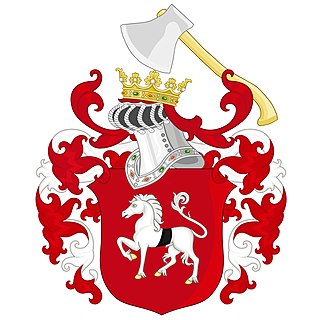
Starykoń is a Polish coat of arms. It was used by several szlachta (noble) families under the Polish–Lithuanian Commonwealth. Notable bearers of this coat of arms include Jan Wielopolski.

Herb Prus III is a Polish coat of arms. It was used by several szlachta families in the times of the Polish–Lithuanian Commonwealth.
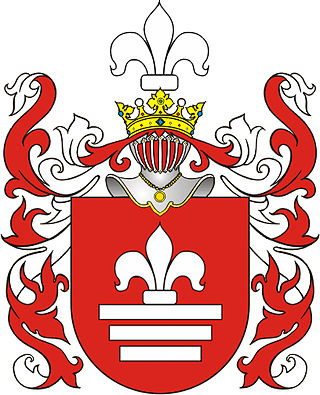
Roch III is a Polish coat of arms. It was used by several szlachta families in the times of the Polish–Lithuanian Commonwealth.

Suchekomnaty is a Polish coat of arms. It was used by several szlachta families in the times of the Polish–Lithuanian Commonwealth.

Przegonia is a Polish coat of arms. It was used by several szlachta families in the times of the Polish–Lithuanian Commonwealth.
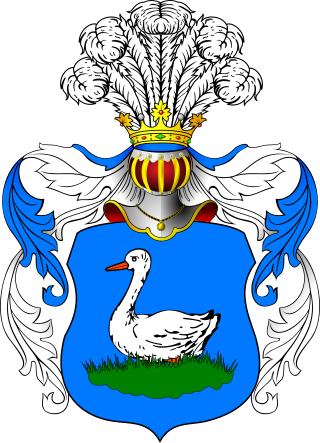
Gąska is a Polish coat of arms. It was used by several szlachta families in the times of the Polish–Lithuanian Commonwealth.
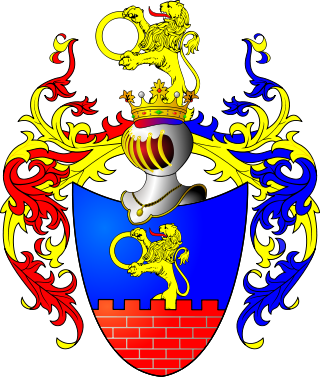
Prawdzic (Prawdzik) was historically a Polish Coat of Arms. It was used by the nobility clans and later szlachta families in the times of the Kingdom of Poland (1385–1569) and Polish–Lithuanian Commonwealth.
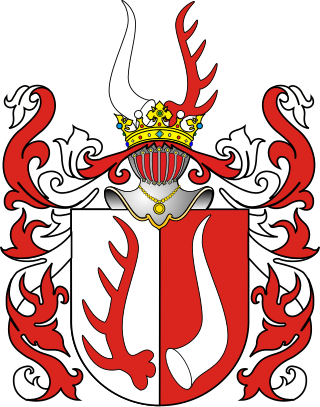
Rogala is a Polish coat of arms, likely imported from Germany to Poland in 1109 by the Rogala or the Ribersztein family, that then added the second horn. It was used by several szlachta families in the times of the Polish–Lithuanian Commonwealth.

Tarnawa is a Polish coat of arms. It was used by several szlachta families in the times of the Polish–Lithuanian Commonwealth.